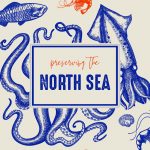The Cost of preservation
On the last night of our journey around Jutland, Jennifer and I were having a conversation in which she put me squarely in my place. We were, as we often find ourselves, working our way through another complication in the world of traditional preservation: salting, pickling, smoking. The discourse of the moment: the cost of preservation. I had made the cavalier suggestion that refrigeration was perhaps the most disastrous technological advancement in modern fishing. Even going so far as to claim that electrical preservation, such as freezers, initiated the rise of large-scale fishing, super trawlers, and even the neo-liberal enclosure of the seas.
My thought was based on the initial belief that freezers permit long fishing expeditions out at sea. With the new capacity to store fish long-term without landing, larger boats become more feasible, mandatory even for the sake of efficiency. And with larger boats, and an equal reduction in manpower, more destructive fishing methods soon followed. Therefore, I quipped, ban electrical preservation and you initiate a return to sustainability; perhaps, it would even be a sustainability directive.
Jennifer’s head whipped around. Her eyes sharp under pressure. And then, to my surprise, she crushed my argument with a single word.
Laeso.
Trading Resources
Half way between the eastern coast of Jutland and the Kattegat coast of Sweden, sits the isle of Laeso. Today it is a lush island of juniper trees and coastal heaths. Sandy hills, five meters high, stand guard between the beaches and the land beyond, where mature deciduous and pine trees mingle. Poking around the yellow leaves blanketing the floor below, one may find chanterelle and porcini mushrooms. If not, there are plenty of berries and rosehips waiting for anyone else eager to fourage some sweets to save as a jelly or in a vinegar in preparation for the long winter nights ahead.
300 years ago, the island would have looked very different. Going all the way back to the time of the Vikings, Laeso has been a major producer of salt. It’s no wonder. There are salt wells along the southern side of the island that are densely steeped in the mineral. Unlike the water off the coast which maintain a salt content of roughly 2%, the wells of Laeso can have as much as 14% salt. This makes for a much more efficient extraction process. As a result, vikings, monks, and eventually industry crowded the tiny, forested Island for centuries to extract the sparkling white crystals. It’s simple: boil the saline water until the flakes form and you can scoop them out. It takes time and, most of all, it take heat. Which explains another reason why the island was such a prime spot to get salt: it had fuel to burn.
And this is the paradox: Laeso’s wealth led to its impoverishment.
Depleting Resources
By the early 1700s Laeso was a wasteland. Its verdant forests cut down, burned. The skies dark with the ash rising from the seething pits of salt. The once cacophonous symphony of birds whistling in the trees was silent. And just like that, with the very last log tossed into the burners, the long history of salt on the island came to an end. This basic element of food preservation, with its magical ability to dry fish and add flavor, had the opposite effect on the terroir of its birth. Rather than preserving Laeso, it had drained the island of life. Desperate to get to one resource, the salt magnates of the era had glutted themselves on the island’s woods until there was nothing left to do, but pack up and look somewhere else.
Smoke, Steam and White Gold.
Located upon the now-excavated sites used in the middle ages, Laeso Salt Works is a foundation dedicated to reestablishing the traditional practice of extracting salt from the local wells on the island in a sustainable way. Using age-old methods of seething the salt in large iron pans, the site is Situated near the capital city of Byrum, population 435. The site has become a major destination for tourism and a cultural center on the island. With the creation of the foundation, support for the archaeological sites has received greater attention.
Jennifer and I had witnessed the steaming steel pans, the mounds of salt, and the orange fire below them. We had inhaled the salty air and the smoky aroma of pine. Heard the popping of bubbles in the water and the moisture popping in the fiber of the wood. And above all the star-like sparkle of the salt piles contained within hand crafted wicker baskets. I had found it all so fantastic. My senses had been imbued in those moments with wonder at the ingenuity of the people from centuries ago who had discovered the magical mineral and a method to get at it.
But in our conversation on that last night in Denmark, Jennifer wasn’t reminding me of the sensuality of the place, but the intensity of resource degradation that had once clear-cut Laeso. Suddenly, it seemed, that I had to consider, in that very moment, Bruno Latour.
Considering Latour
The French anthropologist has for the last several decades been examining the relationship between culture and science. In the final analysis, he suggests, we must remember that our inventions and our traditions rise and fall together. Rather than a duality, he suggests that technologies and humans together create culture. For example It may have been the freezers that permitted the super trawlers, and those technologies may have led to the decline in so many fisheries around the world, including the North Sea. But it’s out of a culture of commodification that we invented the freezer and even the wood burning ovens used in Laeso. Thanks to them, we tore through the forests and the seas.
We cannot dole out blame to one or the other if one creates the other, and vice versa. As long as we continue to rush into geographies rich with natural bounty without considering the ethics of the methods by which we harvest that bounty, new technological methods will continue to be created without considering the ethical limits of that very objective.
As long as we continue to rush into geographies rich with natural bounty without considering the ethics of the methods by which we harvest that bounty, new technological methods will continue to be created without considering the ethical limits of that very objective.
Golden Gifts of the Forest
Laeso is a terrible reminder that this is nothing new. But it’s also a model for hope.
After visiting the salt pans near Byrum, Jennifer and I trundled off into the now pristine forest only a few kilometers down a gravel road. At times the trees and branches were so tightly crowded that I had to crouch and twist my way to get by. But the journey was worth it. An hour or so after beginning our quest among the trunks and dry pines laying in the dirt, I heard Jennifer’s voice from some far way off.
-I found one! Come look. I found one.
Crunching over the broken branches and papery leaves underfoot I made my way over to her. With a shaking, bent finger that seemed somehow childlike in its disbelief, she pointed at a small yellow cap sitting on the ground. My eyes widened. We had found our first chanterelle mushroom.
After the Fire, space for new growth
After centuries of new growth, the forests of Laeso have returned. Although Laeso Salt Works uses only locally harvested pine, it manages its use in such a way that the disaster beset upon the island once, won’t happen again. In this way, they remind us that a symmetry is necessary when trading one resource for another or when using a technology with devastating implications. And further, they demonstrate that abstinence isn’t always the only or even best solution.
These days, the Salt Works provides salt to shops and restaurants around Scandinavia. Perhaps even farther afield than the merchants of old. Chef’s in Copenhagen idolize the ‘white gold’ as having the finest flavor and texture in the world. And the flakes are some of the most expensive too. The people of Laeso are once again trying their hands, and their ovens, at the game of salt. Like a phoenix from the ashes, they’re back.
It’s the same technology with a new ethic.





Recent Comments